Low elevation makes Daytona's Midtown vulnerable to chronic flooding
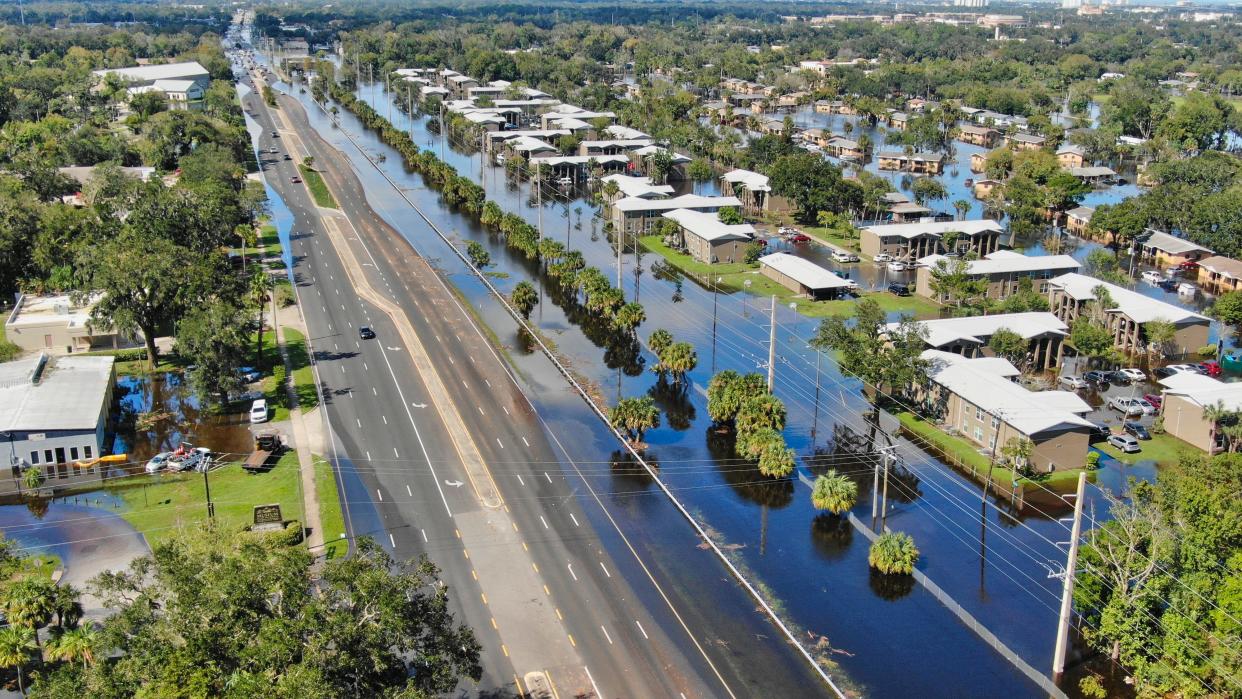
DAYTONA BEACH — A little before 2 a.m. on Sept. 29, Vanessa Lloyd's daughter called her to plead for help. The terrified mother of five young children screamed over the phone that she had sewage water rising inside her house.
Outside, the climbing floodwater taking over her neighborhood just east of Nova Road was too high for emergency workers to drive to her. So she and her husband scooped up their children, waded out into streets that had become rivers and walked through the darkness until they reached Bellevue Avenue, where rescue workers waiting for the petrified family were able to evacuate them.
As Tropical Storm Ian lashed Midtown with brutal 80 mph winds and dumped 17 inches of rain that night and into the next morning, thousands of other people were living the same nightmare throughout the area between Nova Road, Ridgewood Avenue, George Engram Boulevard and Beville Road.
Read an in-depth story on the history of Daytona's Midtown neighborhood: Midtown, Daytona Beach's historic Black neighborhood, struggles to find a better future
Will Daytona Beach's Midtown ever get the help it needs?: Daytona city manager and his staff tour Midtown looking for ways to improve neighborhood
Tropical Storm Ian battered Daytona Beach's Midtown: In Daytona's Midtown, Ian's assault continues on flooded streets, powerless homes
Track storm Nicole: See spaghetti models, path and storm activity for Florida
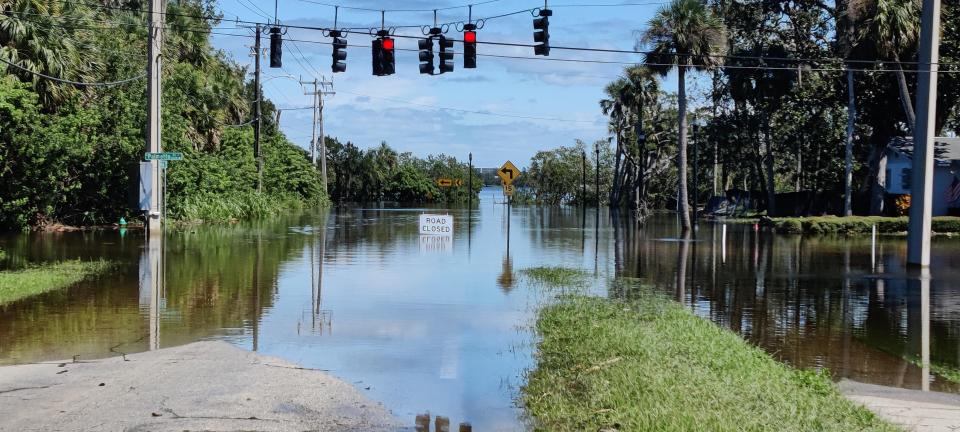
Hundreds of residents in the area were taken to safety in boats and trucks piloted by law enforcement officers, friends, family members and pastors.
That urban core area of Daytona Beach was just one of many parts of the city that were swallowed by the deluge Ian dumped before finally swirling out into the Atlantic Ocean 48 hours after it roared into town.
The downtown blocks closest to the Halifax River, Pelican Bay community and Indigo Lakes neighborhood were all swimming in a few feet of water at the height of the storm that cut a destructive path from the Gulf Coast to Central Florida.
But the Midtown and Fairway Estates neighborhoods just east of Nova Road suffered the worst of the flooding, with the murky water reaching three to four feet and destroying cars and most everything inside the homes in those communities.
Midtown businesses and houses of worship were also devastated. A foot of filthy floodwater made its way into the Islamic Center of Daytona Beach on Keech Street, ruining carpeting, doors and furniture and spurring an explosion of mold.
It's a low-lying area that mostly sits about five to six feet above sea level, with some sections a little higher or lower. The Federal Emergency Management Agency's flood elevation is around eight feet above sea level, and only Midtown buildings that sit at that eight-foot threshold or higher stayed dry inside during Ian.
The Midtown-area topography is like a bowl, and much of the neighborhood sits on the bottom of the bowl that has its highest rims on Ridgewood Avenue and Clyde Morris Boulevard.
When enough water comes pouring down from the sky and the more elevated surrounding areas, sandbags, pumps, retention ponds and the Nova Canal quickly lose the fight.
While people in Pelican Bay and Indigo Lakes were shocked to see their neighborhoods inundated, longtime Midtown residents were not. It's happened in the historically Black community before – again and again, for many decades.
The crushing poverty throughout Midtown and its already beat-up homes and businesses make recovery especially hard. It's where about 500 public housing units are located, and it's home to many of Daytona Beach's poorest residents.
Dozens of those public housing units were submerged in four feet of water, and the Daytona Beach Housing Authority has relocated the tenants to some of its vacant units, hotels and relatives' homes. The flood-damaged units are unlivable, and while the cabinets are replaced and the mold is remediated, the Housing Authority is estimating its hotel bill will climb to $200,000.
Why is Daytona's Midtown so vulnerable to floods?
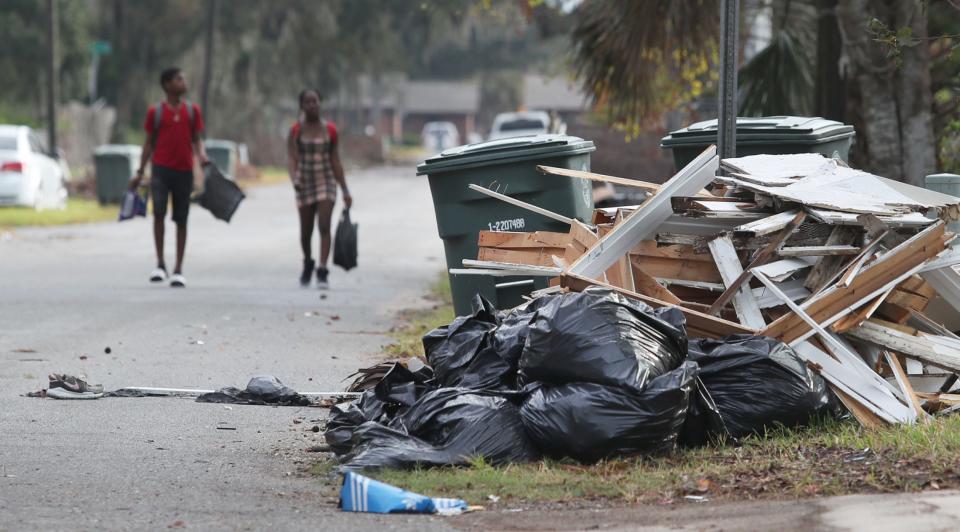
The city made a push to tackle the flooding problem in 2009, when more than 20 inches of rain fell over a six-day period. But so far Daytona Beach hasn't been able to pull together $3 million for the in-depth study needed to come up with a flood mitigation plan, much less the tens of millions of dollars needed to create a new drainage system.
The city is willing to put up $1.5 million for the study, and has made requests in Tallahassee and Washington, D.C., for the other $1.5 million every year since 2009.
Thirteen years later, the city still doesn't have the money to get out of the starting blocks. But after watching the devastation and trauma Ian inflicted on Midtown, a nerve has been struck and city leaders have a new determination to make this time different.
"I hope we're the commission who does something," said City Commissioner Paula Reed, who joked that her yard off of Magnolia Avenue became "Lake Magnolia" on Sept 29.
On Wednesday night, a few days after Reed said she wants to see real progress, the City Commission did do something. City commissioners voted unanimously to use $2.5 million of the federal funds the city received through the Coronavirus Local Fiscal Recovery program to give Daytona Beach residents and business owners grants that will reimburse some of their losses from Tropical Storm Ian.
The city will award grants of up to $9,000 per household and $3,000 per business. Homeowners can use the money for property insurance deductibles, flood and mold remediation costs, lodging expenses incurred by displaced households, relocation expenses and other housing-related costs such as mortgage payments.
Renters can get assistance with rent and deposits. Businesses can use the grant money for repairs, lost revenue, insurance deductibles and replacing spoiled food.
City employees will be at Peabody Auditorium and Allen Chapel AME Church on George Engram Boulevard starting this week to explain details of the program and offer assistance. Days and hours haven't been established yet.
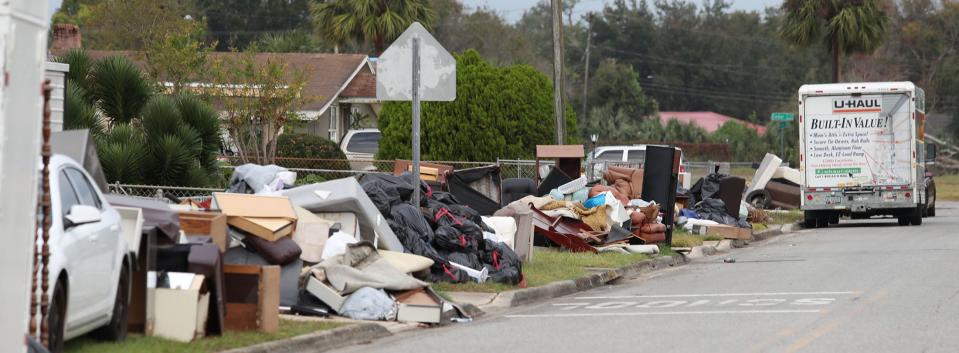
The grants will help the recipients start to get their lives back on track, but they won't help the city solve the underlying problem that will lead to more flooding when the next big storm hits.
Water will always flow into the lowest point it can reach, and in Daytona Beach that's the Midtown neighborhood that's been settled since the 1890s.
"Flooding in Daytona Beach is much more about elevation of the ground, relative to the elevation of the river," said Assistant City Manager Andrew Holmes, who until recently served as Daytona Beach's Public Works director.
Daytona Beach has a storm water pipe network that feeds water east of Interstate 95 into the Halifax River. The tail end of pipes that release that storm water normally sit a few feet above the river's surface, and they're designed to send the runoff on a one-way trip eastward.
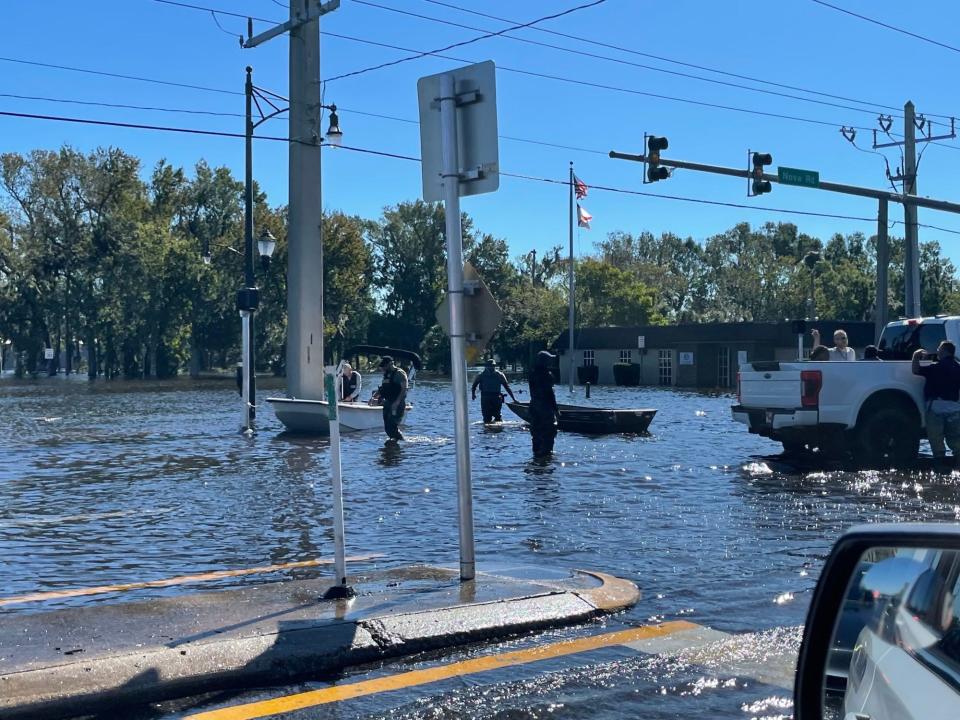
When the river rises at high tide, it's had rain dumped into it, or storm surge pushes the river westward – and sometimes when all three things are happening at once – the Halifax gets so high that the city pipes can no longer do their job.
The river's west bank is around five feet above sea level. If water in the river gets to eight feet above sea level, as happened with Ian, the pipes go under water.
When the river climbs high enough, it can top its banks and start pouring water westward. While that surging river water will typically stay east of the elevated Ridgewood Avenue, the blocked pipes mean any floodwater settled into Midtown is trapped until the river drops back down and water can again flow out of the city lines and into the Halifax.
Because Midtown sits lower than land to its west that steadily rises toward Clyde Morris Boulevard, the water can't flow westward, either.
It doesn't help that many homes, businesses and churches in Midtown were built many years ago at street level, something that would never be allowed under the building codes of recent decades.
While there's a lack of curb and gutter in Midtown, which was also one of the last areas of the city to get paved roads, that doesn't really affect flooding, Holmes said. More modern storm water systems in Midtown help the neighborhood drain more quickly now, but only after the river elevation goes down.
Is Nova Canal the culprit?
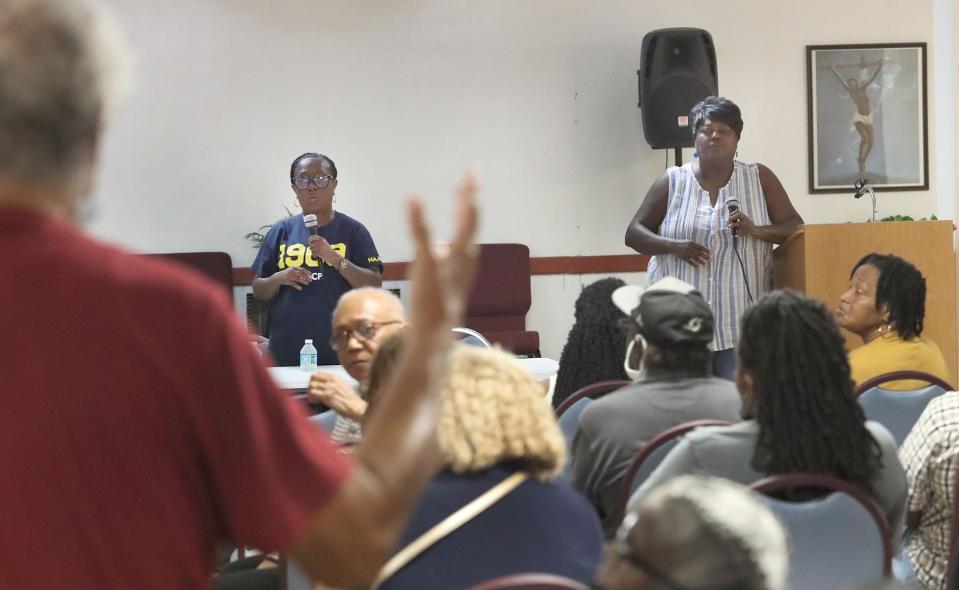
Tuscawilla Park, located on the southwest corner of Nova Road and International Speedway Boulevard, sits lower than both of those roads and becomes a lake during tropical storms or unusually heavy rainfall in a short period of time.
Once Tuscawilla Park fills up, as it did during Ian, that becomes one more onslaught of water that finds its way into the low-lying Midtown. The same thing happens with retention ponds east of Nova Road when the rain falls hour after hour and day after day.
Some people blame the Nova Canal for Midtown's flooding because the open ditch that runs along the neighborhood's western edge also tops its banks during heavy, unrelenting rain.
The state-controlled Nova Canal runs from Ormond Beach south to Port Orange. It has offshoot pipes along its multi-city corridor that reach to the river and release water – when the Halifax doesn't rise so much that it blocks that outflow.
The canal used to be a long open ditch running down the middle of Nova Road, which in decades past was called Canal Road. When the Florida Department of Transportation widened the road about 50 years ago, it also installed storm water pipes and closed most of the open canal.
The section of open canal beside Midtown is one of the few areas that didn't switch to underground piping.
Mayor Derrick Henry said people have used Nova Canal like a trash dump, chucking everything from water bottles to mattresses to televisions into the deep ditch. It would help to keep the channel running freely when water rushes through, but that wouldn't fix the neighborhood's flood problems, Holmes said.
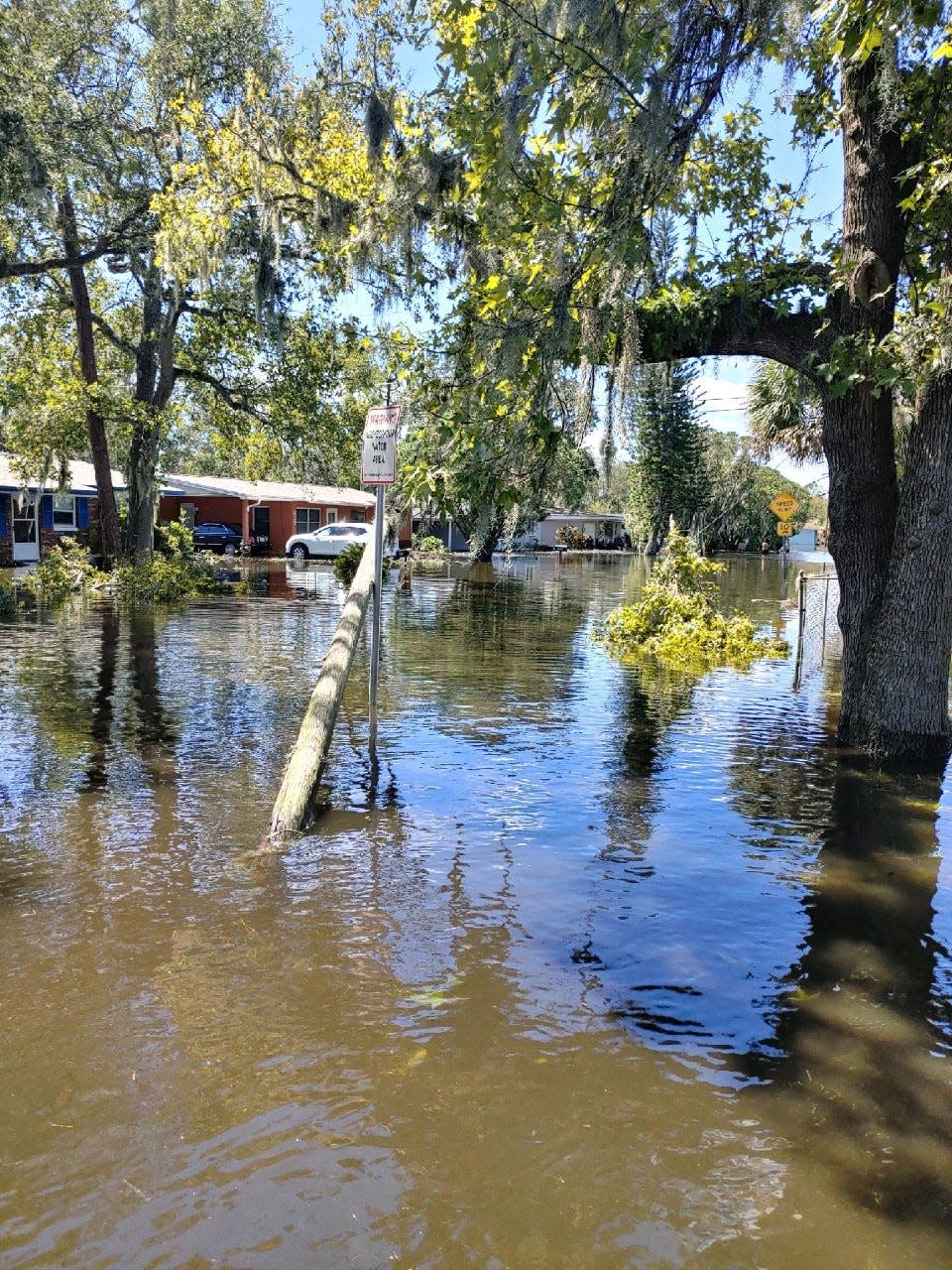
In the final analysis, the canal beside Midtown is not the main reason the neighborhood has too often found itself engulfed, Holmes said.
"The Nova Canal has capacity problems when the rainfall is so intense that it causes flooding in Midtown, but I don't know that it's causing the flooding," he said. "I would stop short of saying that. The same factors that make Midtown flood also make the Nova Canal go over a little bit."
He doesn't think it matters that the canal used to go down middle of Nova Road, or that some sections are closed now and some are open. When the area floods, the canal is all under water any way, he pointed out.
"I think it (the canal) needs to be looked at, and it might be part of the solution, but I don't think it's the cause of all our flooding," Holmes said.
A new multi-city drainage system is needed
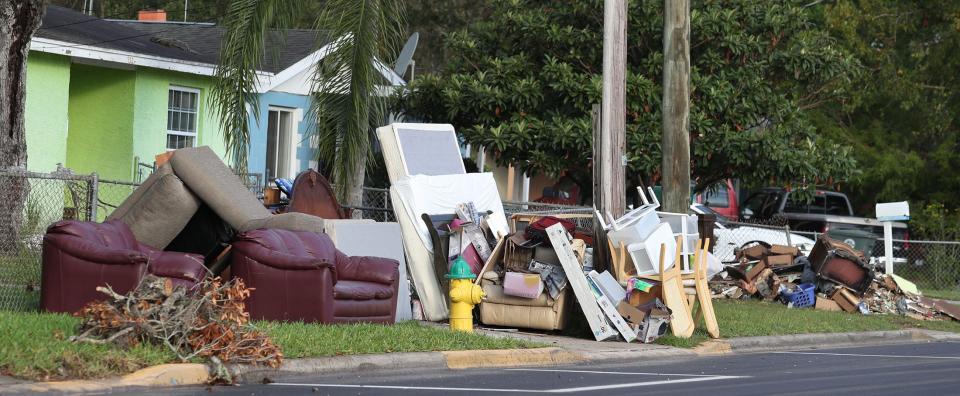
Many years ago, there were other canals in Daytona Beach around Ridgewood Avenue that have since been closed off. Those canals might have cleared water out faster after a flood, but they probably would not have prevented any flooding, he said.
Navy Canal still exists just west of Nova Road across from Midtown, and it drains water from west to east, but it probably doesn't play a role in whether Midtown floods, Holmes said.
Midtown's flooding foe is simply low elevation, he said.
"In Midtown the land is very low and very flat, so the water tends to accumulate in the low areas," Holmes said. "It doesn't have as much to do with the piping system or the drains or the pipes in the road that drain the road in a normal rainfall event, because that in a flood is all well under water."
Diverting the water to the municipal golf course or adding more retention ponds might help, but not when the river is so high that the outflow pipes are underwater, he said.
Holmes said he can't speculate on what might finally relieve flooding in Midtown.
"It's $3 million of work to get those answers," he said, referring to the study cost.
The ultimate solution will have to be a regional system since water doesn't stop at city borders, he said.
'Our street looked like the Atlantic Ocean'
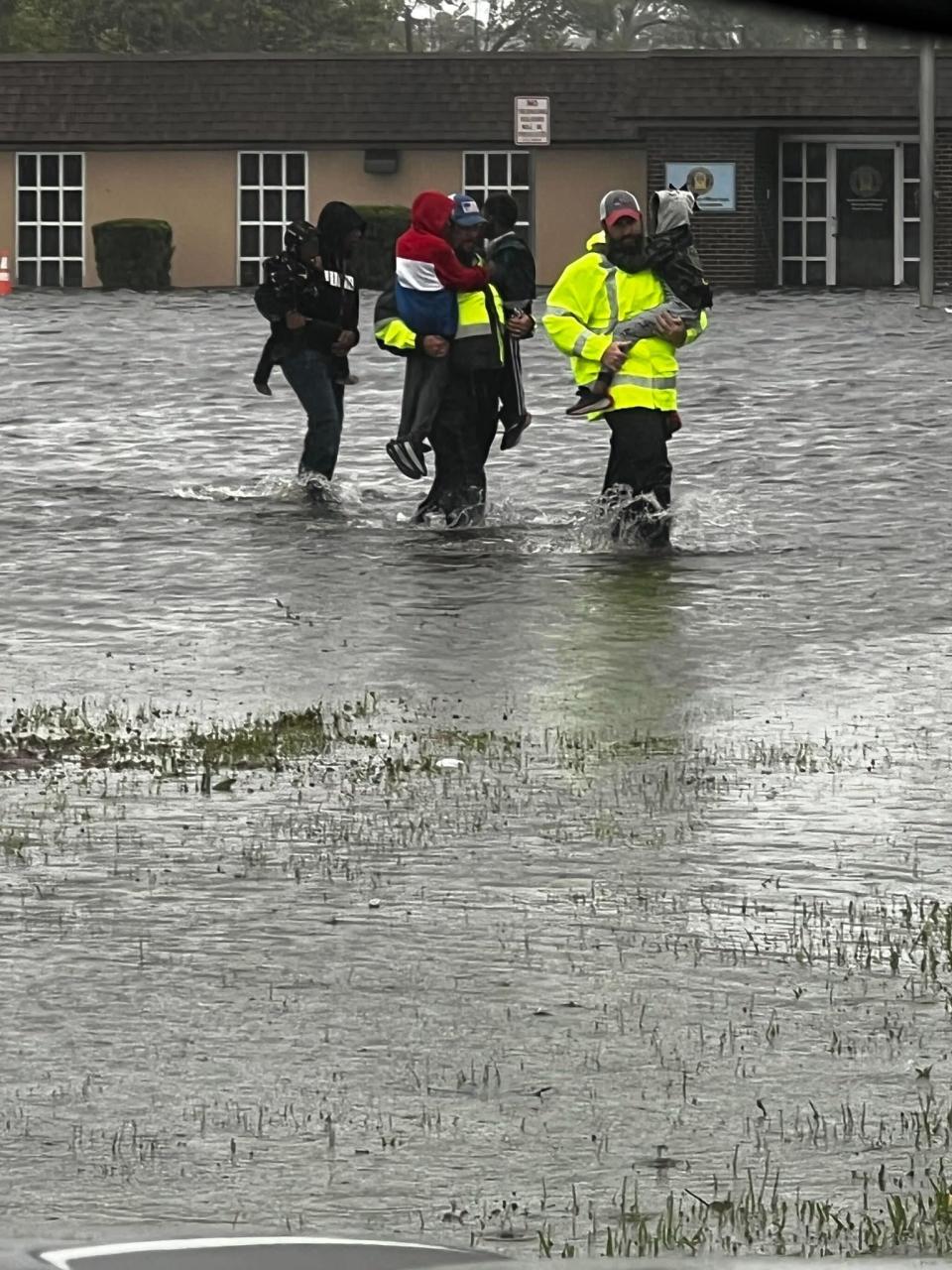
On the night of Oct. 27, more than 100 people packed into the basement of Mount Zion AME Church, located in the heart of Midtown on Martin Luther King Jr. Boulevard.
For nearly two hours, the neighborhood residents shared heartbreaking stories of what Tropical Storm Ian stole from them. Many of them lost most everything they owned, and even their ability to live in their homes.
Robert E. Brown, Sr., said the floodwater around his house rose four feet above the ground.
"The waves were so high it broke my windows," said Brown, who lives off of South Street. "I've been here 62 years, and this is the fourth time I lost my house."
Lucinda Mayo said her 82-year-old mother "lost everything she owns."
"It hurt me to my heart to put my mom's stuff she had for life on the side of the road," Mayo said.
Another woman who has lived on Willie Drive since 1968 said she's staying with her daughter now because the flooding caused extensive damage to her house.
"Our street looked like the Atlantic Ocean," she said.
Now her road "looks like a war zone" with people's water-damaged belongings and pungent piles of trash with maggots crawling around sitting next to the road, she said.
A man at the meeting said he had three feet of water inside his house.
"There are people in their 60s, 70s and 80s in this neighborhood who shouldn't be going through this," another man at the meeting said.
Another man said his wife went into labor during the storm, and the couple had to walk to an ambulance on Nova Road because the emergency vehicle couldn't make it through the high water.
Barbara McGill is ready to push the six Daytona Beach city commissioners and mayor toward fully tackling the flooding problem.
"Let's put some fire under the seven," McGill said. "I've got the match, baby."
Daytona Beach NAACP President Cynthia Slater, who ran the meeting inside the church, has been trying to work with the city on flooding solutions. But she also understood the suffering of the people she listened to inside the house of worship.
Slater had three feet of water inside her Kottle Circle home at the height of Tropical Storm Ian, and she lost 90% of her belongings.
This is the fourth time in 30 years flooding has caused extensive damage to her house, and she's asking herself if she wants to chance a fifth time.
She has lived in Midtown her whole life, back to the 1950s, and she doesn't want to leave. But the repeated flooding is wearing her down.
She fled her house the morning of Sept. 29, driving across a neighbor's yard just to stay on higher ground long enough to find a way out of the neighborhood.
The group inside Mount Zion AME Church also discussed what can be done to stop the next high-water tragedy. They suggested everything from vacuum trucks to suck up water to water-tight doors.
One man said the city needs to dig deeper retention ponds in Midtown, and add a retention pond to the municipal golf course that's on the south end of the neighborhood.
"You're talking about human health and safety," he said. "What's more important? That or golf?"
Reed suggested turning the site of the one-story Caroline Village public housing units into a large retention pond and building new housing in a different part of the neighborhood.
Midtown's flooding problem goes back to the neighborhood's earliest days more than 100 years ago, and a real solution is overdue, Slater said. Some say the flooding in Midtown has been getting worse over the years, and Ian was the worst they've ever seen. They don't want to wait for it to get even more calamitous.
"I'm afraid of a cloud now," Slater said. "I've talked to residents. They can't take another day of this."
How is Daytona reacting to Ian flooding?
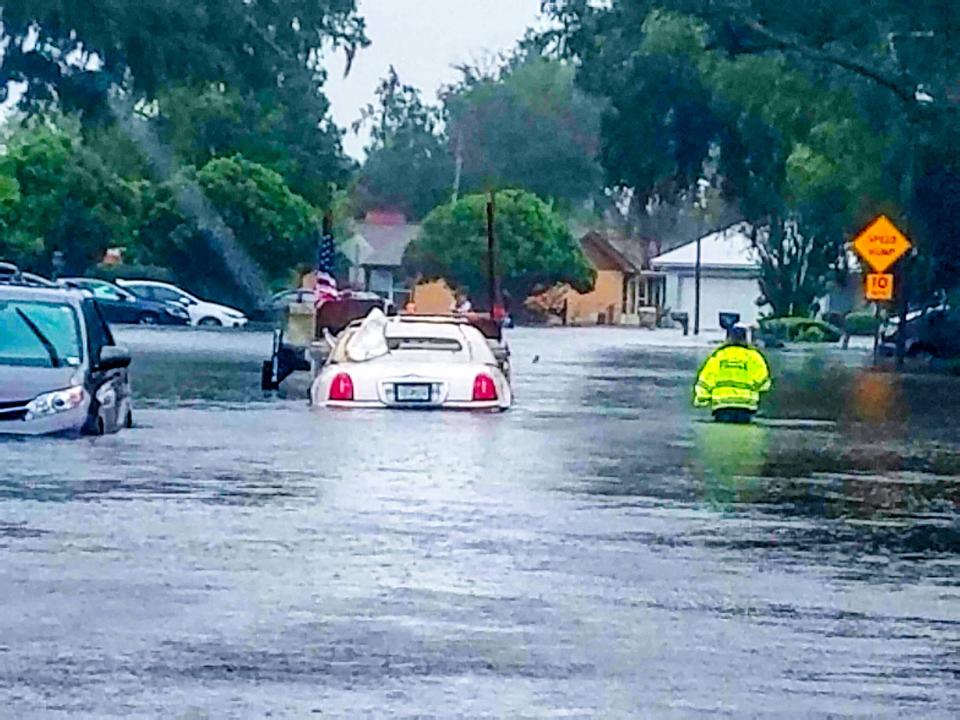
Henry is happy to have Daytona Beach lead the way on searching for a solution to the chronic flooding between Nova Road and the Halifax River. But he hopes the other cities along that corridor from Ormond Beach to Port Orange also join the effort.
Henry and City Manager Deric Feacher also hope county government and state officials will lock arms with east Volusia municipal leaders on the new quest to ease the pain flooding has inflicted on local residents and business owners.
"What I think will be different is we'll have a unified message, and everyone will speak from the same sheet of music," said Feacher, who has been Daytona Beach's city manager for a little under 18 months.
Feacher hopes community groups, neighborhood associations, colleges, organizations including the local branch of the NAACP and developers also get involved. The city manager and his staff has also met with state Department of Transportation officials and representatives with the U.S. Department of Housing and Urban Development to deal with flood prevention and recovery from all angles.
"We need to really build up a contingency of individuals with state and local officials to tell federal government leaders about the importance of expediting money for this area," Feacher said.
Henry, several commissioners and city staff have contacted various elected officials to share photos and videos of the extensive damage inflicted by Ian.
At their Oct. 15 meeting, city commissioners approved sending letters to U.S. Rep. Michael Waltz, U.S. Sen. Rick Scott and U.S. Sen. Marco Rubio requesting their help in securing federal funds for Daytona Beach's recovery from Ian and for future flood mitigation projects.
Soon Henry, Feacher and other local leaders will travel to the state's and nation's capitals to have face-to-face meetings with government officials. The mayor has also received messages of support from Vice President Kamala Harris and spoken with her staff members.
"We don't want anyone to forget the seniors and children our police officers were carrying out" of the flooded areas, Feacher said. "If we have another one of these storms, it could do that again."
Gov. Ron DeSantis, Florida gubernatorial candidate Charlie Christ, Waltz, Rubio and state legislators representing the area all visited Daytona Beach just after Ian blew across the World's Most Famous Beach, sparking hope that they'll use the weight of their offices to help.
"I think they got an eye opening of what happened in Daytona Beach, and I think they'll do what's right," Feacher said.
Rubio drove around Midtown with Reed and Sheriff Mike Chitwood just after the storm passed.
Rubio "saw people's lives out on the road," Reed said, referring to piles of furniture, appliances, clothing and other personal belongings destroyed by water that made it into homes.
The senator also helped give out free meals at Campbell Middle School, Reed said.
Then Rubio sat down with several local leaders to better understand what heavy rains do to parts of Daytona Beach.
Officials from New Smyrna Beach, Daytona Beach Shores and Ormond Beach also met with Rubio.
What happens next?
The U.S. Army Corps of Engineers only takes on about five new projects nationwide each year, and usually only two of those new projects involve flooding problems, Feacher said. So Daytona Beach needs to be as aggressive as possible in trying to get on the Corps' project list, he said.
A preliminary design report was drafted following the major rain event in 2009, when 790 structures were damaged by more than 20 inches of rain that fell in six days. The report recommended a regional solution with a total bill of $100 million.
Unable to pull together $100 million for flooding problems, the city submitted a request to Congress to approve funding a feasibility study and design solutions by the U.S. Army Corps of Engineers. Congress approved Daytona Beach’s project under the Water Authorization Bill in 2016, but six years later the city is still waiting for Congress to appropriate funding.
The study is vital. It's a prerequisite for federal funding. The city might have to consider a temporary tax, perhaps one that would be in place for just one year, to raise the money for the study and get things moving, Feacher said.
But it's going to take federal money to create new storm water drainage systems and strategies, he said.
"We can't tax our way out of this problem," the city manager said. "The citizens don't have enough money."
Flood mitigation projects in New Orleans have cost more than $14.5 billion.
What's been done to help so far
While the city has waited for help, it has gone ahead and tackled parts of the overall flood mitigation plan. The city has installed backflow preventers in the banks of the Nova Canal, upgraded aging storm water pipes in outfalls, installed pump stations and built storm water capacity at North Street and Mark Street.
The city has sunk more than $5.5 million into eight storm water projects in the Midtown area since the catastrophic flooding in 2009. Most of the projects aimed to speed up drainage after a flood or just normal rainfall.
One of those eight projects replaced dual corrugated metal arch culverts with triple reinforced concrete pipes from Ridgewood Avenue to the Halifax River. Located at South Street, it's the only outfall for the Midtown area that experienced heavy flooding in 2009.
The project cost $1.8 million and was completed in January 2011.
The city also installed 15 backflow preventers on all storm water discharges into the Nova Canal between Orange Avenue and Beville Road. The project cost $468,468 and was completed in May 2013.
The city also invested millions in an overhaul of Orange Avenue and some of the infrastructure below the main Midtown artery, which has allowed water to drain away more quickly. But work on the corridor wasn't intended to be a flood control project, Holmes said.
The city also does smaller things when tropical storms and hurricanes point toward Daytona Beach to try to lessen the blow.
When it became clear Ian was on its way to central Florida, Utilities Department crews worked prior to the storm to clean storm inlets and storm water lines, pump down retention areas and place temporary pumps in strategic locations. During the storm, 100 employees worked 2,900 hours to keep water, sewer and storm water operations running in spite of not having power at some point at all three treatment plants.
Midtown residents appreciate all those efforts, but they're demanding that dramatic changes begin as quickly as possible. Residents in their 70s and 80s can't remember a time when Midtown flooding wasn't a part of their lives.
In the early 1950s, when 79-year-old Patricia Heard was about 11 years old and living in the South Street public housing complex, she and her family were rescued in a rowboat when a large storm dumped massive amounts of rain on the neighborhood.
Slater remembers playing in the floodwater in her north Midtown neighborhood as a child in the late 1950s and 1960s, and building a makeshift boat she and her friends cobbled together with wood from a vacant lot and her father's tools.
"I can remember Hurricane Donna (in 1960) when I was about four or five years old," said Slater, whose childhood home was just north of what is now Mary McLeod Bethune Boulevard. "There were wooden houses in the neighborhood then that sat on cinder blocks. The houses did better, but the streets were flooded. I don't remember getting water in our house."
Slater and Heard don't want another generation of children to grow up in a place where their houses are always one bad storm away from destruction.
"We have to be more proactive and less reactive," Slater said. "We're going to come together to figure out how to fix this."
You can reach Eileen at Eileen.Zaffiro@news-jrnl.com
This article originally appeared on The Daytona Beach News-Journal: Daytona Beach determined to alleviate flooding in its Midtown area

